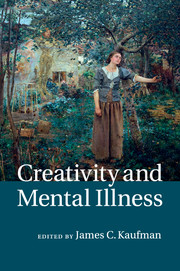Book contents
- Frontmatter
- Dedication
- Contents
- List of figures
- List of tables
- List of contributors
- Preface
- Acknowledgments
- Part I Creativity and mental illness: the state of the field
- Part II Cognitive and neuroscientific perspectives on creativity and mental illness
- Part III Creativity and the spectrum of mental illness
- 9 Creativity and the spectrum of affective and schizophrenic psychoses
- 10 When good is bad and bad is good: mood, bipolarity, and creativity
- 11 Attention-deficit/hyperactivity disorder and creativity: ever the twain shall meet?
- Part IV Creativity and mental illness: possible commonalities
- Part V Creativity and mental health
- Part VI Creativity and mental illness: what now?
- Index
- References
9 - Creativity and the spectrum of affective and schizophrenic psychoses
from Part III - Creativity and the spectrum of mental illness
Published online by Cambridge University Press: 05 August 2014
- Frontmatter
- Dedication
- Contents
- List of figures
- List of tables
- List of contributors
- Preface
- Acknowledgments
- Part I Creativity and mental illness: the state of the field
- Part II Cognitive and neuroscientific perspectives on creativity and mental illness
- Part III Creativity and the spectrum of mental illness
- 9 Creativity and the spectrum of affective and schizophrenic psychoses
- 10 When good is bad and bad is good: mood, bipolarity, and creativity
- 11 Attention-deficit/hyperactivity disorder and creativity: ever the twain shall meet?
- Part IV Creativity and mental illness: possible commonalities
- Part V Creativity and mental health
- Part VI Creativity and mental illness: what now?
- Index
- References
Summary
The possible connection between madness and creativity is a highly controversial issue. This is barely surprising, because it touches upon fundamental, human nature, issues that resonate beyond the scientific arena. In a sense, the subject borders on themes that can be regarded as distributive justice (Does one need to “pay a price” for having superior gifts?), “poetic” justice (Are those cursed with mental suffering at least compensated with an easier access to the muse?), and ethics (If we could eradicate the genetics of psychosis, would we actually be removing the genetic reservoir of unique human qualities such as creativity?).
Some would consider that the question itself is fundamentally wrong for various reasons. Humanistic and positive psychology schools view it as an attempt to pathologize what is essentially a positive feature that arises in healthy and self-actualized individuals (e.g., Fromm, 1980). Others claim that the whole theme survives as a cultural myth derived from inaccurate historical reinterpretations of the association between melancholia and creativity established by Greek philosophers (e.g., Schlesinger, 2009). Finally, many have criticized the lack of “strong” methods to prove the connection, which has relied on anecdotal descriptions of mad geniuses for a long time. All of these criticisms contain grains of truth and not surprisingly are brought up when the issue is presented in terms of madness being a necessary condition for creativity or creativity leading to madness. However, as will be elaborated, the recognition of multiple ingredients in both creativity and madness and the addition of more sound methods challenge the simple dismissal of this topic.
- Type
- Chapter
- Information
- Creativity and Mental Illness , pp. 169 - 204Publisher: Cambridge University PressPrint publication year: 2014
References
- 3
- Cited by



